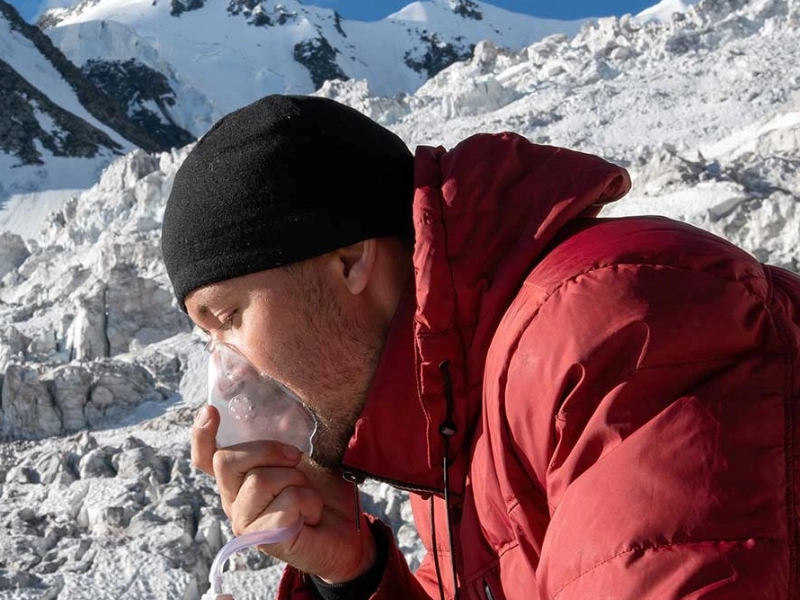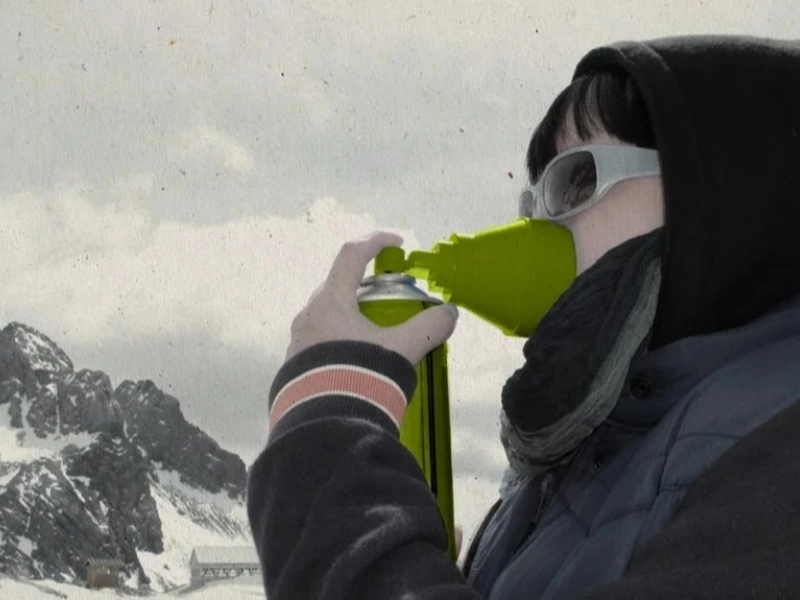A wide range of physiological and cognitive alterations can be brought on by high altitude. The majority of these modifications are caused by variations in oxygen supply and atmospheric pressure. When going to high elevations, people with diabetes or brain tumors should exercise extra caution. High-altitude cerebral edema (HAPE), a more severe form of altitude sickness, may strike these people. Fluid accumulation in the brain and lungs is the cause of HAPE, which can be fatal.
 An increase in altitude causes the body to naturally produce more red blood cells in order to carry more oxygen into the breath. However, when a person climbs too quickly, this increase in oxygen cannot meet the demand. Low oxygen levels as a result might cause headaches, exhaustion, and nausea.
Less severe cases of altitude sickness typically pass in a day or two. However, more severe symptoms, such as HAPE (high-altitude pulmonary edema), require immediate medical attention. Individuals suffering from HAPE may experience dyspnea and/or fluid accumulation in one or more lung regions. Using a stethoscope to listen to the lungs and an ophthalmoscope to examine the eyes for fluid accumulation, medical professionals can diagnose HAPE. X-rays may also reveal HAPE symptoms.
Altitude sickness is more common in those with particular medical disorders, such as sickle cell anemia, COPD, and unstable angina. Even with treatment to aid in acclimatization, these individuals should refrain from ascending to elevations beyond 8,000 feet.
An increase in altitude causes the body to naturally produce more red blood cells in order to carry more oxygen into the breath. However, when a person climbs too quickly, this increase in oxygen cannot meet the demand. Low oxygen levels as a result might cause headaches, exhaustion, and nausea.
Less severe cases of altitude sickness typically pass in a day or two. However, more severe symptoms, such as HAPE (high-altitude pulmonary edema), require immediate medical attention. Individuals suffering from HAPE may experience dyspnea and/or fluid accumulation in one or more lung regions. Using a stethoscope to listen to the lungs and an ophthalmoscope to examine the eyes for fluid accumulation, medical professionals can diagnose HAPE. X-rays may also reveal HAPE symptoms.
Altitude sickness is more common in those with particular medical disorders, such as sickle cell anemia, COPD, and unstable angina. Even with treatment to aid in acclimatization, these individuals should refrain from ascending to elevations beyond 8,000 feet.
 Low oxygen levels in the brain at high altitudes lead to blood vessel leakage. The brain swells as a result of this fluid, forcing it up against the skull. This is a severe issue that may result in symptoms such as dizziness, exhaustion, and cognitive impairment. Additionally, the fluid may harm the visual nerves, leading to hemorrhages in the retina. A coma may result from high-altitude cerebral edema (HACE) in severe circumstances.
In addition to starving the brain of oxygen, low oxygen levels can cause the white matter in the brain to become stiffer and more susceptible to clotting. The cerebral cortex, which is responsible for higher-order motor control and conscious thought, may be impacted by this.
Chronic exposure to high heights harms the brain even in those without significant symptoms, as demonstrated by Fayed's study of amateur climbers. On their treks to Kilimanjaro and Aconcagua, climbers who did not take the time to acclimate exhibited evidence of damage in the form of cortical atrophy and larger Virchow-Robin gaps, which appear on an MRI scan as white birdshot.
Low oxygen levels in the brain at high altitudes lead to blood vessel leakage. The brain swells as a result of this fluid, forcing it up against the skull. This is a severe issue that may result in symptoms such as dizziness, exhaustion, and cognitive impairment. Additionally, the fluid may harm the visual nerves, leading to hemorrhages in the retina. A coma may result from high-altitude cerebral edema (HACE) in severe circumstances.
In addition to starving the brain of oxygen, low oxygen levels can cause the white matter in the brain to become stiffer and more susceptible to clotting. The cerebral cortex, which is responsible for higher-order motor control and conscious thought, may be impacted by this.
Chronic exposure to high heights harms the brain even in those without significant symptoms, as demonstrated by Fayed's study of amateur climbers. On their treks to Kilimanjaro and Aconcagua, climbers who did not take the time to acclimate exhibited evidence of damage in the form of cortical atrophy and larger Virchow-Robin gaps, which appear on an MRI scan as white birdshot.
 In most cases, mild symptoms disappear when you drop below a certain height. It might be helpful to take ibuprofen for the headache and to drink lots of water. Professional mountain climbers carry dexamethasone, a steroid that lowers brain swelling, as one of the additional drugs that may be utilized. It's a medical emergency; therefore, you should descend right away if the symptoms get worse.
High-altitude pulmonary edema is one of the more severe symptoms; it is characterized by an accumulation of fluid in the lungs and, if left untreated, can be fatal in a matter of hours. The most prevalent kind of altitude sickness is identified by a dry cough, pale lips and skin, or a crackling sound that occurs with each breath.
Altitude sickness is more common in people who are less physically fit, live near sea level, or have medical conditions like cardiac issues. Additionally, those who have previously experienced altitude sickness are more vulnerable.
In most cases, mild symptoms disappear when you drop below a certain height. It might be helpful to take ibuprofen for the headache and to drink lots of water. Professional mountain climbers carry dexamethasone, a steroid that lowers brain swelling, as one of the additional drugs that may be utilized. It's a medical emergency; therefore, you should descend right away if the symptoms get worse.
High-altitude pulmonary edema is one of the more severe symptoms; it is characterized by an accumulation of fluid in the lungs and, if left untreated, can be fatal in a matter of hours. The most prevalent kind of altitude sickness is identified by a dry cough, pale lips and skin, or a crackling sound that occurs with each breath.
Altitude sickness is more common in people who are less physically fit, live near sea level, or have medical conditions like cardiac issues. Additionally, those who have previously experienced altitude sickness are more vulnerable.
 While there isn't a single, effective method for avoiding altitude sickness, generally speaking, relaxing and gradually increasing your altitude can be helpful. It's crucial to talk to your doctor about any plans you have to climb at high elevations, particularly if you have any medical conditions like diabetes, heart issues, or breathing difficulties. Certain antidepressants, antipsychotics, birth control pills, and other medications that produce blood clots are likely to be incompatible with high altitudes, as are many medications for neurological diseases like epilepsy.
The best course of action is to quickly descend to a lower altitude if AMS symptoms appear. Physicians can treat patients suffering from the most severe type of altitude sickness, known as HAPE, by administering pure oxygen using a portable hyperbaric chamber called a Gamow bag, named for its inventor. It is also possible to minimize brain swelling using oral medications such as acetazolamide and dexamethasone and to stabilize the blood flow to the lungs with salmeterol inhalation.
While there isn't a single, effective method for avoiding altitude sickness, generally speaking, relaxing and gradually increasing your altitude can be helpful. It's crucial to talk to your doctor about any plans you have to climb at high elevations, particularly if you have any medical conditions like diabetes, heart issues, or breathing difficulties. Certain antidepressants, antipsychotics, birth control pills, and other medications that produce blood clots are likely to be incompatible with high altitudes, as are many medications for neurological diseases like epilepsy.
The best course of action is to quickly descend to a lower altitude if AMS symptoms appear. Physicians can treat patients suffering from the most severe type of altitude sickness, known as HAPE, by administering pure oxygen using a portable hyperbaric chamber called a Gamow bag, named for its inventor. It is also possible to minimize brain swelling using oral medications such as acetazolamide and dexamethasone and to stabilize the blood flow to the lungs with salmeterol inhalation.